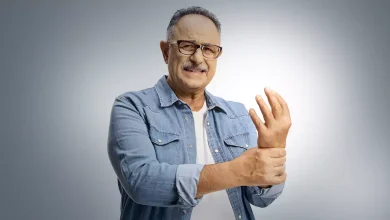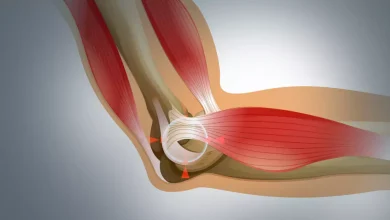All about Cervical Spondylosis
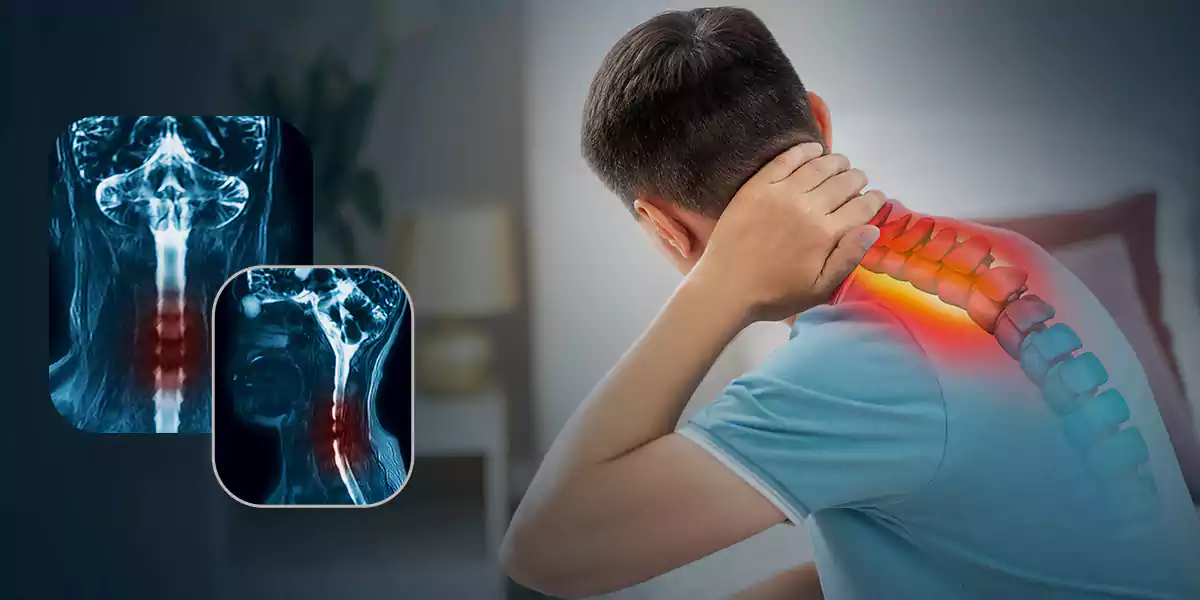
What is Cervical Spondylosis?
Cervical Spondylosis is the general term given to the common, age-related ailment that affects the joint and discs in the cervical spine located in the neck. It mostly affects people above the age of sixty and keeps worsening with the age. Cervical spondylosis develops from wear and tear of cartilage and bones because of age but it may sometimes occur due to some other causes also. Almost everyone after the age of sixty gets affected by this problem and 85% of the people who crossed the age of sixty have cervical spondylosis.
What are the Types of Cervical Spondylosis?
Cervical spondylosis is a general and nonspecific term that includes an extensive spectrum of afflictions and it can be divided into three types.
- Cervical Radiculopathy: Also known as “pinched nerve” it develops because a nerve in the neck is compressed resulting in it branching away from the spinal cord. Most of the time, it causes pain and numbness in the nerve’s pathway into the arm and hand, based on where the damaged roots are positioned.
- Cervical Myelopathy: It occurs when the spinal cord in the neck (cervical area of the spine) is compressed. Pain or stiffness in the neck, loss of balance, and trouble walking are a few symptoms of cervical myelopathy.
- Axial Spondyloarthritis: It mostly affects the spine and the sacroiliac (SI) joints that link the lower spine to the pelvis. Its main symptoms include pain in the lower back, hips, and buttocks.
Most of the people who are affected by cervical spondylosis show no symptoms but pain and stiffness in the neck can be regarded as its main symptoms. Still, there are a few things someone affected by cervical spondylosis may experience which we can take as the symptoms of cervical spondylosis:
What are the Symptoms of Cervical Spondylosis?
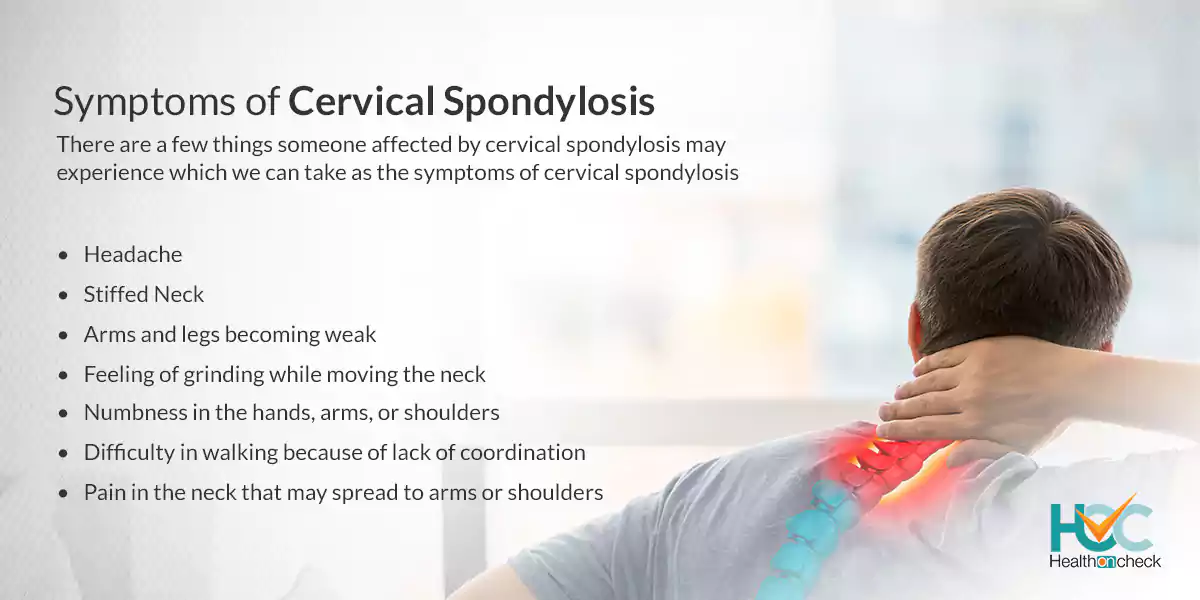
- Pain in the neck that may spread to arms or shoulders
- Headache
- Feeling of grinding while moving the neck
- Arms and legs becoming weak
- Difficulty in walking because of lack of coordination
- Numbness in the hands, arms, or shoulders
- Stiffed Neck
- Difficulty in controlling bladder and bowels
What are the Causes of Cervical Spondylosis?
Ageing and chronic wear on the cervical spine are the main causes of cervical spondylosis and it’s a common problem among people with age above sixty. With growing age, the backbone and neck slowly develop wear and tear resulting in changes in the body. These changes may result in:
- Degeneration of Discs: The spinal bones have discs with a gel-like substance inside them that acts as cushions. After the age of forty, these disks start shrinking and drying resulting in more bone to bone contact.
- Herniated Discs: The tearing and cracking in the spinal disc because of normal ageing results in a herniated disc. It makes the disc swell out because of pressing on adjacent tissue or a spinal nerve. This pressure can result in pain, tingling, or numbness in the neck.
- Osteoarthritis: It develops when the protective cartilage that cushions the ends of the bones wears down over a period. Osteoarthritis, fasten the process of cartilage degeneration, a condition that everyone develops while ageing.
- Bone Spurs: When the disc starts to wear and tear, sometimes the body starts producing new bones in an abnormal way known as bone spurs. It is a common problem that develops with age and most of the time, there are no symptoms.
Apart from the natural causes of cervical spondylosis, some outside factors can make someone more prone to develop spondylosis are:
- Obesity and no physical exercise
- History of neck injury
- Spine surgery in the past
- Slipped disc
- Already suffering from arthritis
What are the Risk Factors Associated with Cervical Spondylosis?
Old age is the most common risk factor associated with cervical spondylosis. Along with age, there are more chances of you experiencing neck pain or other things related to cervical spondylosis if you have any of these:
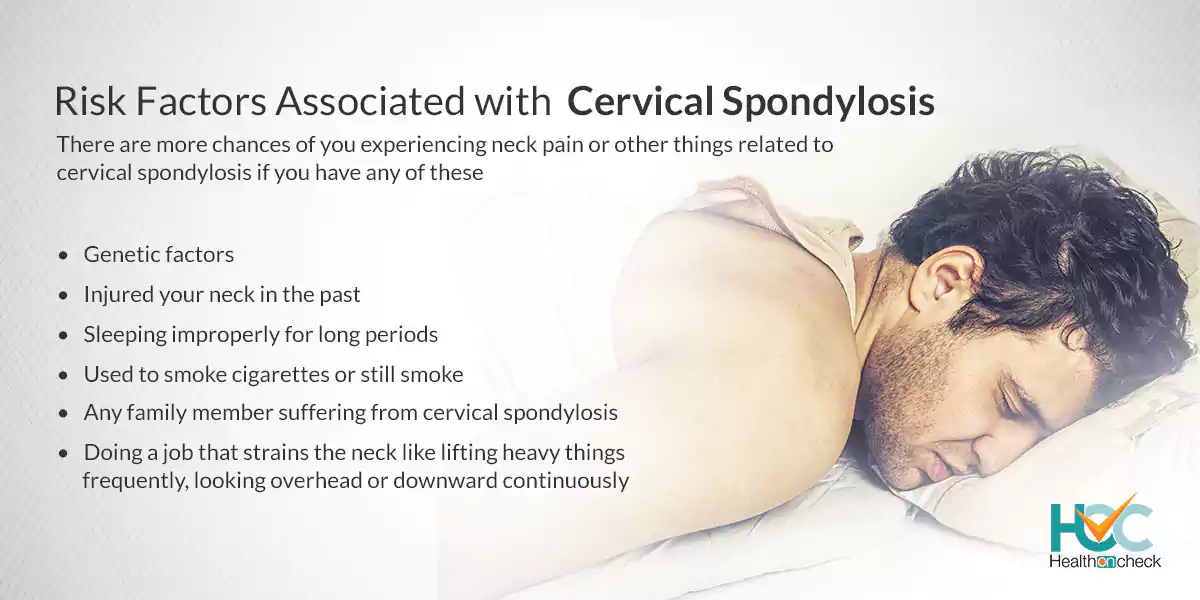
- Used to smoke cigarettes or still smoke
- Any family member suffering from cervical spondylosis
- Doing a job that strains the neck like lifting heavy things frequently, looking overhead or downward continuously
- Sleeping improperly for long periods
- Injured your neck in the past
- Genetic factors
How is Cervical Spondylosis Diagnosed?
If you have pain in your neck for some time or any other symptom of cervical spondylosis, consult a doctor who can diagnose if you have cervical spondylosis or not. A physical examination may be carried out to check your
- Muscle strength
- Reflexes, especially in your hands, arms, and legs
- Flexibility of the neck
- How are you walking
- Trigger points in your neck and shoulder
Most of the time, the above mentioned things are enough to diagnose cervical spondylosis but sometimes a few tests are required to check the symptoms and diagnose cervical spondylosis. Some of the tests are as follows
- X-Rays Test: Checking the X-rays is very helpful to diagnose this condition as it shows the bones in your neck, their alignment, loss of bone, and bone spurs if any. Not all bone changes need to be because of cervical spondylosis. If you are feeling pain and discomfort in your neck for some time, X-rays and other tests can check for other reasons also such as a spine tumor
- Computed Tomography (CT) Scans: CT scans give more details as compared to X-rays and provide better views to check the spinal bones and bone spurs.
- Magnetic Resonance Imaging (MRI): MRI provides detailed images of soft tissues such as cartilage, nerve roots, muscles, spinal cord, and disks. It can give more details than X-rays along with finding the source and location of the pain.
- A few other tests like myelogram (kind of CT scan) or electromyogram (nerve function test) can give more details on how cervical spondylosis may be affecting your bones.
What Are The Treatment Options For Cervical Spondylosis?
Many times, cervical spondylosis shows no symptoms and without symptoms, there is no need for treatment.
In case you have constant pain in your neck or feel uncomfortable while moving your neck along with showing other symptoms of cervical spondylosis, conservative treatments can effectively treat the majority of cases barring a few very rare and severe cases. Your doctor may recommend treatment options such as:
- Physical Therapy: Some symptoms of cervical spondylosis can be cured just with a few specific exercises and stretches without any medication or other major treatment procedures. As the name suggests, physical therapy involves certain exercises, stretches, and a little bit of change in your lifestyle habits like the way you sit, sleep, etc.
- Massage Therapy: Various types of massages are also used to cure a few symptoms of cervical spondylosis. You can visit a massage therapist, who performs acupuncture or someone who is a specialist in spinal manipulation (a chiropractor, osteopathic doctor, or physical therapist). Ice, heat, and massage which you can do yourself can also relieve some symptoms. Here you have the massage the area of your neck where it’s paining with ice and heat for around twenty minutes, several times a day. It can help to reduce the pain.
- Medicines: In some cases, if the symptoms are not reducing and the pain is still there after physical therapy and massages, your doctor may prescribe over-the-counter anti-inflammatory medicines depending on the severity of the pain. These medicines can remove the pain temporarily or permanently depending on the type and severity of symptoms you have.
- Soft Collar: Wearing a therapeutic collar can reduce the pain but wear it only after consulting your doctor or physician. It helps the strained muscles to rest and recuperate by limiting neck movements. Remember to wear it for short period as wearing it for long period may result in muscle atrophy (wasting away).
- Injections: In some cases of cervical spondylosis, pain relieving steroids are injected in the neck or into the area next to your spinal bones to decrease the pain or to completely cure the symptoms.
- Surgery: Though very rare, in very severe cases like cervical myelopathy or cervical radiculopathy, surgery may be suggested by your doctor to get rid of the symptoms and pain. The surgical procedure may include confiscating bone spurs and combining the vertebrae or making more space for the spinal cord by getting rid of a portion of vertebrae.
What are the Complications of Cervical Spondylosis?
Many times, cervical spondylosis may not even show symptoms and it’s mostly age-related which can occur after you crossed the age of sixty. In case you have symptoms of cervical spondylosis for a long time, some complications it can lead to are:
Nerve Compression: If you are suffering from cervical spondylosis for a long period of time, especially after crossing the age of sixty, nerve complication is a complication you have to endure. Based on the nerves, continuous nerve compression may result in a condition known as cervical radiculopathy, where you may feel a tickling sensation in the arms and legs which can numb or make them weaker. Some other ailments of cervical radiculopathy are severe in the shoulders and chest, problems in body coordination and walking, irregular spinal reflexes, loss of bladder and bowel control.
Spinal Stenosis: If unattended for a noticeably long time, cervical spondylosis may lead to another condition known as spinal stenosis in which the spinal canal is affected. It narrows downs the spinal canal which may harm the spinal cord. Its symptoms are similar to cervical radiculopathy such as a tingling sensation with constant pain in the shoulders, arms, and legs and a lack of body coordination.
Permanent Disability: Though rare but severe symptoms of cervical spondylosis for a long period of time may result in permanent disability. Conditions like cervical myelopathy and cervical radiculopathy can lead to constant damage to the vertebrae. In such cases, it becomes very difficult to even walk and do normal daily activities which may affect your work and personal life severely. If not cured after physical treatment, massages, and medication, surgery remains the only option to reduce pain and restore a few functionalities of your body.
Living with Cervical Spondylosis
In most cases of cervical spondylosis, you may not even have any symptoms and can lead a normal life. With age, the symptoms like neck pain and stiffness start and if you are young then also these symptoms may arise because of the kind of work you do or doing activities that cause your head and neck to be out of good alignment for a long time. Luckily, most of the symptoms such as pain and discomfort in the neck can be cured with some prescribed physical exercise, massage, and medication.
In the cases of disk herniation, pinched nerves, bone spurs, and nerve compression more medical care may be required such as taking medicines, injecting steroids, and surgery. But leaving some rare cases, you can live a normal life with some small efforts like following the physical exercise prescribed, massaging, and not doing activities that may strain your neck.
Whom to Consult?
In most cases, symptoms like pain and discomfort in the neck go away after a brief period of time. If these symptoms are there for a long time, consult a doctor and seek his help. Also apart from pain and discomfort in the neck, other symptoms such as numbness in arms and chest, finding difficulty while walking, loss of bladder and bowel control arises, seek medical help immediately.



